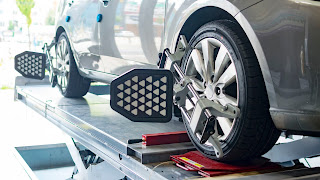Necessary Wheel Alignment And Balancing For Your Car Tyres In Blacktown
The car tyres are the contact points of a vehicle to the road and play a vital role in ensuring maximum confidence for the driver. Your car is an elaborate system of interconnected working parts. If any one of these parts is impaired, it’s only a subject of time until the other connected parts are impacted. One problem that can get out of hand fast is inaccurate wheel alignment. The alignment of your wheels highly affects your suspension and the health of car tyres in Blacktown.
Wheel Alignment
Alignment guides an adjustment to a vehicle’s suspension – the system that links a vehicle to its wheels. It is not an adjustment of the car tyres or wheels themselves. Instead, the key to proper alignment is adjusting the angles of the tyres, which impacts how they make contact with the road.
When checking your alignment, a mechanic is mainly involved with three things-
Camber – This is the inward or outward angle of the tyre when considered from the front. Too much outward or inward tilt, also known as positive or negative camber, signifies improper alignment and will need to be changed. Worn bearings, ball joints and additional wheel suspension parts may also lead to camber misalignment.
Toe – Toe alignment is the degree to which your tyres turn inward or outward when considered from above. To learn this, look down at your own feet. If your toes angle outward, you have toe-out alignment and vice versa for toe-in alignment.
Caster – Your caster angle enables balance stability, steering and cornering. A negative caster represents the steering axis tilting towards the front of the vehicle. A positive caster depicts the steering axis will lean towards the driver.
Once all the above three angels get back in synchronization, the right wheel alignment is achieved.
Reasons For Improper Wheel Alignment
A typical cause of a vehicle’s wheels going out of alignment is the sudden impact of hitting something at enough speed.
Encounters with manholes and potholes without lids can significantly damage your car’s suspension, wheel balancing, and alignment and will drastically harm your vehicle’s fuel efficiency and, much seriously, your safety.
Minor collisions and hitting a curb can also take a car out of alignment, but drivers overlook them because of minor visible damage.
Symptoms of incorrect wheel alignment
Besides car tyres Blacktown wear and wear patterns, wheel alignment is essential for safe driving to relieve strains and success on vehicle suspension parts and enhance vehicle handling.
If you presume that you may need a wheel alignment, here are a few symptoms and signs to check for-
Car pulling to either side – To inspect if you have an alignment problem, take your vehicle to a flat parking lot or drive down the center of a vacant road and pay close attention to how your steering reacts.
Vibrating steering wheel – Another indication that your alignment is incorrect is if your steering wheel vibrates at higher speeds. If not speedily addressed, this can severely affect tyre wear and generate a flat or tyre blowout. You could also face a problem related to the suspension.
Uneven tyre wear – Misalignment significantly impacts car tyres' wear and health. One of the typical causes of tyre wear is an insufficiency of smooth rotation. A tyre that is not aligned makes other wear patterns show up, such as extreme wear on the inside and outside edges of a tyre.
Wheel Balancing
Wheel balancing is necessary to smooth driving, safety, tyre wear, and stability and lets the tyres spin without causing vibrations.
Unlike wheel alignment, tyre balancing refers to compensation for any weight imbalances in the tyre or wheel combination. It is often accomplished in conjunction with wheel alignment.
When balancing your wheels, wheels should permanently be suspended off the car, as the modern wheel balancer does both dynamic and fixed balance simultaneously.
How is wheel balancing accomplished?
Step 1- All four tyres are taken off the vehicle and positioned on a computerized wheel balancer.
Step 2- All four wheels are individually tested for weight imbalance, and the computer simulates all the distinctive irregularities.
Step 3- The weight imbalance is fixed by placing counterweights on the rim at the identical spot where the computer guides.
Step 4-The wheels are rechecked if the imbalance continues.
When To Consider Proper Alignment and Balancing?
On average, you should have your alignment and balancing checked every 5,000 – 6,000 kilometers and automatically every time you switch to new tyres.
But don’t postpone getting it done. Instead, make sure you visit a reputed tyre fitment center that specializes in every characteristic of tyre maintenance and performance to execute a successful, assured outcome.
Conclusion
Motoring experts now believe that two trends: lightweight suspension systems and lower profile tyres, have raised the need to have a more routine balancing and alignment as these newer models are more susceptible to imbalance than heavier and older cars.
Wheel alignment and balancing are vital for the extraordinary life of car tyres. However, improper wheel alignment and balancing can cause issues with how your vehicle operates.
Besides being a safety threat, it negatively impacts your tyre tread and stability, markedly lowers your vehicle’s fuel efficiency, and dramatically affects the all-around performance of your car.
Vibrating steering wheel, uneven tread wear, pulling, or an off-center are all indicators that your safety on the road may be at threat. If you are looking for proper alignment or balancing of car tyres in Blacktown, visit Big Wheels Tyre and Auto and let the team of specialists conduct a safety check to ensure your car is as secure to drive as you think.
Disclaimer: This is generic Information & post; content about the services can be changed from time to time as per your requirements and contract. To get the latest and updated information, contact us today or visit our website.

.png)
Comments
Post a Comment